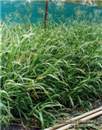Scientific name(s)
Urochloa mosambicensis
Strengths
- Fast growing in spring
- Excellent drought survival ability
- Grows well on a wide range of soil types and environments
- Tolerates heavy grazing
- Tolerates lower fertility than most sown grasses with some salinity tolerance
- Responsive to increased soil fertility
- Good seed producer and can be harvested mechanically
- Few pests and diseases
Limitations
- Matures quickly and dries off early in autumn
- Sensitive to frost
- Not suited to heavy clays
Plant description
Plant: stoloniferous and loosely tufted, sprawling lower branches, sometimes rooting from lower nodes, 30-100 cm high
Stems: branching and from 50 - 100 cm tall, or trailing, hairy nodes
Leaves: often pale green, hairy, 20 - 80 cm long, up to 1.5 cm wide
Seedhead: 3-15 branches, 2-8 cm long, seeds in 2 symmetrical rows
Seeds: vary from a dull green to straw in colour, to 1M seeds/kg.
Pasture type and use
Summer growing perennial grass used in tropical cattle grazing systems, roadside stabilisation and mine rehabilitation. Palatable plant with good forage quality when green.
Where it grows
Rainfall
500 - 1300 mm/annum
Soils
Well adapted to a wide range of well drained, not waterlogged, soils including sands, loams and lighter clay soils of low to high fertility. Tolerant of lower fertility than alternative sown grasses. Some salinity tolerance.
Temperature
Summer growing grass with most production occurring in the warmer months, responding rapidly to spring and early summer rainfall; dries off rapidly in autumn. Plants frosted in winter but shoot in early spring when moisture is available.
Establishment
Companion species
Grasses: Not usually sown with grasses; has invaded run-down buffel pastures and grown with Indian couch (Bothriochloa pertusa)
Legumes: Not usually sown with legumes; Potential legumes vary from the tropics to the sub-tropics and with soil type; Sown legumes, include the summer growing legumes stylo (Stylosanthes spp.), desmanthus (Desmanthus virgatus), butterfly pea (Clitoria ternatea), leucaena (Leucaena leucocephala) and lucerne (Medicago sativa), and annual winter growing medic cultivars (Medicago spp.).
Sowing/planting rates as single species
2-4 kg/ha; usual seed quality (germination and purity) and maturity considerations, 600,000-1 M seeds/kg. Sow up to 2 cm deep.
Sowing/planting rates in mixtures
1-4 kg/ha, sow at a pro rata rate depending on the number of species in the mixture; sowing rate is unchanged when sown with legumes.
Sowing time
On spring to early summer rainfall or mid-January to February to avoid heat wave periods. Freshly harvested untreated seed remains dormant for the current season (6 months), but can be hammer-milled to remove the inhibiting glumes for earlier sowing.
Inoculation
Not applicable
Fertiliser
Varies with soil texture, fertility and rainfall; responds to phosphorus (to 35 kg P/ha) and nitrogen (to 100kg N/ha).
Management
Maintenance fertliser
Not usually fertilised for grazing; Depending on soil -responds to nitrogen (to 100 kg/ha) and phosphorus. High rates for seed production.
Grazing/cutting
Heavy grazing, cutting and fire tolerant, responds rapidly to spring/early summer rain and is selectively grazed, can become 'papery' in a dry autumn even before frosting
Seed production
Usually 100 kg/ha/year by direct mechanical harvesting, but up to 300kg/ha/year is possible by fertilising and multiple harvests in a long growing season.
Ability to spread
Good ability to spread by seed and stolons, adapted to low fertility soils. Fast growing seedlings.
Weed potential
Potential competitor in ungrazed sites e.g. roadsides.
Major pests
No significant pests under grazing.
Major diseases
No significant diseases under grazing.
Herbicide susceptibility
Glyphosate (Roundup) susceptible, tolerates atrazine to 4L/ha.
Animal production
Feeding value
High quality when green and growing; CP in fertilised young leaf to 20% and IVDMD to 70% declining rapidly when mature to less than 10% CP and 45% IVDMD. Phosphorus range of 0.1-0.6% depending on soil fertility and fertiliser. Sodium levels 0.1-1.5% varies with soils.
Palatability
High palatability when growing, lower on maturity.
Production potential
0.5-5t DM/ha depending on soils and fertiliser (N and P rates), producing 80-360 kg LWG /ha/year (the higher levels with fertiliser and companion legumes).
Livestock disorders/toxicity
No disorders or toxicity.
Cultivars
| Cultivar | Seed source/Information |
| Nixon | Public variety (opportunistic harvesting), Southedge Seeds, Rural Agents, Progressive Seeds P/L (most pasture seed companies can source seed). |
Saraji | Progressive Seeds P/L, Rural Agents. |
 Denotes that this variety is protected by Plant Breeder's Rights Australia
Denotes that this variety is protected by Plant Breeder's Rights Australia
Further information
Burt, R.L., Sinclair, D.F., Harrison, P., Pengelly, B.C. and Williams, W.T. (1980) Preliminary agronomic evaluation of some perennial Urochloa species over a range of environments. Australian Journal of Experimental Agriculture and Animal Husbandry, 20, 439-446.
Burt, R.L., Williams, W.T., Gillard, P. and Pengelly, B.C. (1980) Variation within and between some perennial Urochloa species. Australian Journal of Botany, 28, 343-356.
http://www.fao.org/ag/AGP/AGPC/doc/Gbase/data/pf000337.htm
Acknowledgements
-
Author and date
Trevor J. Hall
2 December 2008




